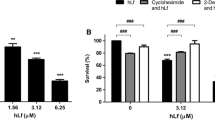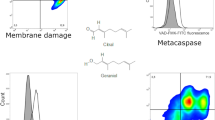Abstract
Mancozeb (MZ), a mixture of ethylene-bis-dithiocarbamate manganese and zinc salts, is one of the most widely used fungicides in agriculture. Toxicologic studies in mammals and mammalian cells indicate that this fungicide can cause neurological and cytological disorders, putatively associated with pro-oxidant and apoptotic effects. Yeast adaptation to sub-inhibitory concentrations of MZ has been correlated with oxidative response, proteins degradation, and energy metabolism, and its main effect on yeast has been attributed to its high reactivity with thiol groups in proteins. Herein, we show that acute MZ treatments on aerobic exponentially growing yeast of wild type (BY4741) and deletion mutant strains, coupled with multiplex flow cytometry analysis, conclusively demonstrated that MZ displays the typical features of pro-oxidant activity on Saccharomyces, elevating mitochondrial ROS, and causing hyper-polarization of mitochondrial membranes leading to apoptosis. A drastic reduction of cellular viability associated with the maintenance of cell membrane integrity, as well as phosphatidyl serine externalization on yeast cells exposed to MZ, also supports an apoptotic mode of action. Moreover, abrogation of the apoptotic response in yca1 deficient mutants indicates that metacaspase-1 is involved in the programmed cell death mechanism induced by MZ in yeast.





Similar content being viewed by others
References
Gullino ML, Tinivella F, Garibaldi A, Kemmitt GM, Bacci L, Sheppard B (2010) Mancozeb: past, present, and future. Plant Dis 94:1076–1087. doi:10.1094/PDIS-94-9-1076
Zhou Y, Shei FS, Piccardo P, Montine TJ, Zhang J (2004) Proteosomal inhibition induced by manganese ethylene-bis-dithiocarbamate: relevance to Parkinson’s disease. Neuroscience 128:281–291. doi:10.1016/j.neuroscience.2004.06.048
Corsini E, Birindelli S, Fustinoni S, De Paschale G, Mammone T, Visentin S, Galli CL, Marinovich M, Colosio C (2005) Immunomodulatory effects of the fungicide Mancozeb in agricultural workers. Toxicol Appl Pharmacol 208:178–185. doi:10.1016/j.taap.2005.02.011
Kamel F, Engel LS, Gladen BC, Hoppin JA, Alavanja MC, Sandler DP (2005) Neurologic symptoms in licensed private pesticide applications in the agricultural health study. Environ Health Perspect 113:877–882. doi:10.1289/ehp.7645
Calviello G, Piccioni E, Boninsegna A, Tedesco B, Maggiano N, Serini S, Wolf FI, Palozza P (2006) DNA damage and apoptosis induction by the pesticide Mancozeb in rat cells: involvement of the oxidative mechanism. Toxicol Appl Pharmacol 211:87–96. doi:10.1016/j.taap.2005.06.001
Domico LM, Cooper KR, Bernard LP, Zeevalk GD (2007) Reactive oxygen species generation by the ethylene-bis-dithiocarbamate (EBDC) fungicide mancozeb and its contribution to neuronal toxicity in mesencephalic cells. Neurotoxicology 28:1079–1091. doi:10.1016/j.neuro.2007.04.008
Srivastava AK, Ali W, Singh R, Bhui K, Tyagi S, Al-Khedhairy AA, Srivastava PK, Musarrat J, Shukla Y (2012) Mancozeb-induces genotoxicity and apoptosis in cultured human lymphocytes. Life Sci 90:815–824. doi:10.1016/j.lfs.2011.12.013
Fitsanakis VA, Amarnath V, Moore JT, Montine KS, Zhang J, Montine TJ (2002) Catalysis of catechol oxidation by metal-dithiocarbamate complexes in pesticides. Free Radical Bio Med 33:1714–1723. doi:10.1016/S0891-5849(02)01169-3
Xie J, Potter A, Xie W, Lynch C, Seefeldt T (2014) Evaluation of a dithiocarbamate derivative as a model of thiol oxidative stress in H9c2 rat cardiomyocytes. Free Radical Biol Med 70:214–222. doi:10.1016/j.freeradbiomed.2014.02.022
Cabras P, Angioni A (2000) Pesticide residues in grapes, wine, and their processing products. J Agric Food Chem 48:967–973. doi:10.1021/jf990727a
Santos PM, Simões T, Sá-Correia I (2009) Insights into yeast adaptive response to the agricultural fungicide mancozeb: a toxicoproteomics approach. Proteomics 9:657–670. doi:10.1002/pmic.200800452
Dias PJ, Teixeira MC, Telo JP, Sá-Correia I (2010) Insights into the mechanisms of toxicity and tolerance to the agricultural fungicide Mancozeb in yeast, as suggested by a chemogenomic approach. OMICS 14:211–227. doi:10.1089/omi.2009.0134
Teixeira MC, Dia PJ, Simões T, Sá-Correia I (2008) Yeast adaptation to mancozeb involves the up-regulation of FLR1 under the coordinate control of Yap1, Rpn4, Pdr3, and Yrr1. Biochem Biophys Res 367:249–255. doi:10.1016/j.bbrc.2007.12.056
Monteiro PT, Dias PJ, Ropers D, Oliveira AL, Sá-Correia I, Teixeira MC, Freitas AT (2011) Qualitative modelling and formal verification of the FLR1 gene mancozeb response in Saccharomyces cerevisiae. IET Syst Biol 5:308–316. doi:10.1049/iet-syb.2011.0001
Casalone E, Bonelli E, Polsinelli M (2010) Effects of Mancozeb and other dithiocarbamate fungicides on Saccharomyces cerevisiae: the role of mitochondrial petite mutants in dithiocarbamate tolerance. Folia Microbiol 55:593–597. doi:10.1007/s12223-010-0095-5
Delobel P, Tesnière C (2014) A simple FCM method to avoid misinterpretation of Saccharomyces cerevisiae cell cycle assessment between G0 and sub-G1. PLoS One 9:e84645. doi:10.1371/journal.pone.0084645
Carmona-Gutierrez D, Eisenberg T, Büttner S, Meisinger C, Kroemer G, Madeo F (2010) Apoptosis in yeast: triggers, pathways, subroutines. Cell Death Differ 17:763–773. doi:10.1038/cdd.2009.219
Wloch-Salomon DM, Bem AE (2012) Types of cell death and methods of their detection in yeast Saccharomyces cerevisiae. J Appl Microbiol 114:287–298. doi:10.1111/jam.12024
Perrone GG, Tan SX, Dawes IW (2008) Reactive oxygen species and yeast apoptosis. Biochem Biophys Acta 1783:1354–1368. doi:10.1016/j.bbamcr.2008.01.023
Farrugia G, Balzan R (2012) Oxidative stress and programmed cell death in yeast. Front Oncol 2:1–21. doi:10.3389/fonc.2012.00064
Bussche JV, Soares EV (2011) Lead induces oxidative stress and phenotypic markers of apoptosis in Saccharomyces. Appl Microbiol Biotechnol 90:679–687. doi:10.1007/s00253-010-3056-7
Madeo F, Frohlich E, Frohlich KU (1997) A yeast mutant showing diagnostic markers of early and late apoptosis. J Cell Biol 139:729–734. doi:10.1083/jcb.139.3.729
Lefevre S, Sliwa D, Auchère F, Brossas C, Ruckenstuhl C, Boggetto N, Lesuisse E, Madeo F, Camadro JM, Santos R (2012) The yeast metacaspase is implicated in oxidative stress response in frataxin-deficient cells. FEBS Lett 586:143–148. doi:10.1016/j.febslet.2011.12.002
Zdralevic M, Guaragnella N, Antonacci L, Marra E, Giannattasio S (2012) Yeast as a tool to study signaling pathways in mitochondrial stress response and cytoprotection. ScientificWorldJournal. doi:10.1100/2012/912147
Pozniakovsky AI, Knorre DA, Markova OV, Hyman AA, Skulachev VP, Severin F (2005) Role of mitochondria in the pheromone- and amiodarone-induced programmed death of yeast. J Cell Biol 168:257–269. doi:10.1083/jcb.200408145
Nargund AM, Avery SV, Houghton JE (2008) Cadmium induces a heterogeneous and caspase-dependent apoptotic response in Saccharomyces cerevisiae. Apoptosis 13:811–821. doi:10.1007/s10495-008-0215-8
Pereira C, Silva RD, Saraiva L, Johansson B, Sousa MJ, Côrte-Real M (2008) Mitochondria-dependent apoptosis in yeast. Biochim Biophys Acta 1783:1286–1302. doi:10.1016/j.bbamcr.2008.03.010
Pagani MA, Casamayor A, Serrano R, Atrian S, Ariño J (2007) Disruption of iron homeostasis in Saccharomyces cerevisiae by high zinc levels: a genome-wide study. Mol Microbiol 65:521–537. doi:10.1016/j.bbamcr.2008.03.010
Acknowledgments
The authors acknowledge Cytogene Diagnósticos Moleculares Ltda. for access to flow cytometry equipment. F. J. Scariot thanks Coordenação de Aperfeiçoamento de Pessoal de Nivel Superior for fellowship support.
Author information
Authors and Affiliations
Corresponding author
Ethics declarations
Conflict of interest
The authors declare that they have no conflict of interest.
Electronic supplementary material
Below is the link to the electronic supplementary material.
Rights and permissions
About this article
Cite this article
Scariot, F.J., Jahn, L.M., Maianti, J.P. et al. The fungicide Mancozeb induces metacaspase-dependent apoptotic cell death in Saccharomyces cerevisiae BY4741. Apoptosis 21, 866–872 (2016). https://doi.org/10.1007/s10495-016-1251-4
Published:
Issue Date:
DOI: https://doi.org/10.1007/s10495-016-1251-4




